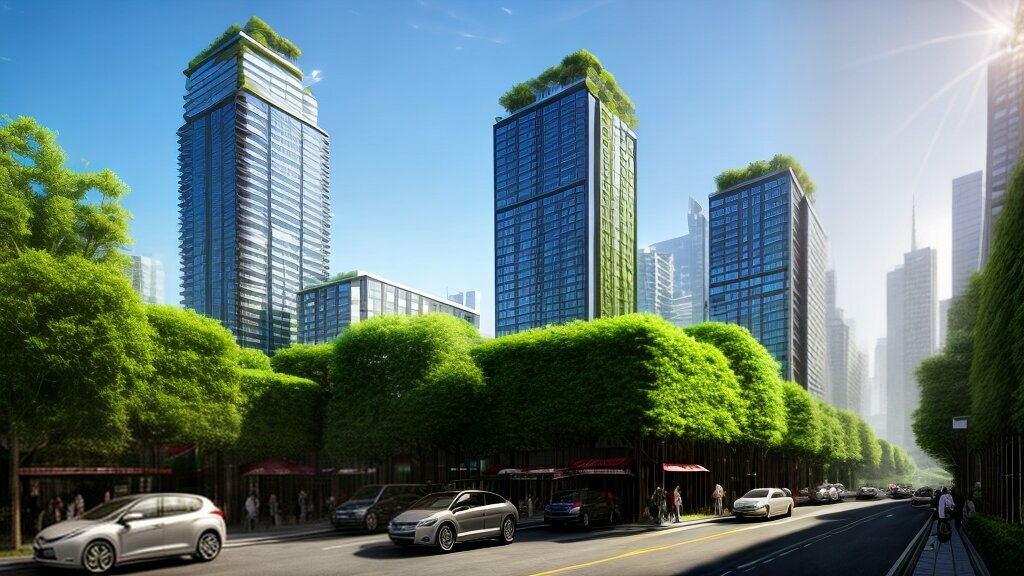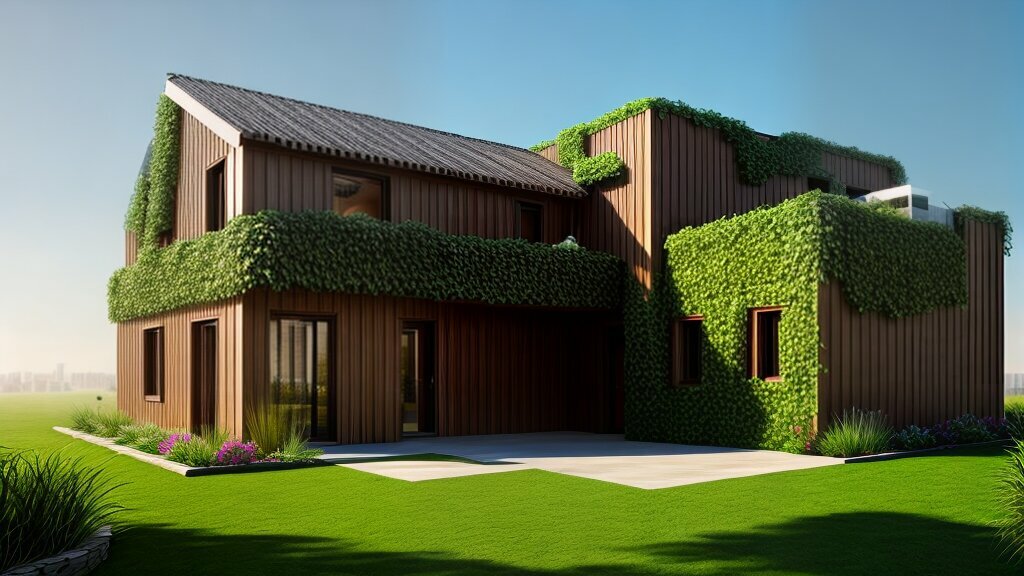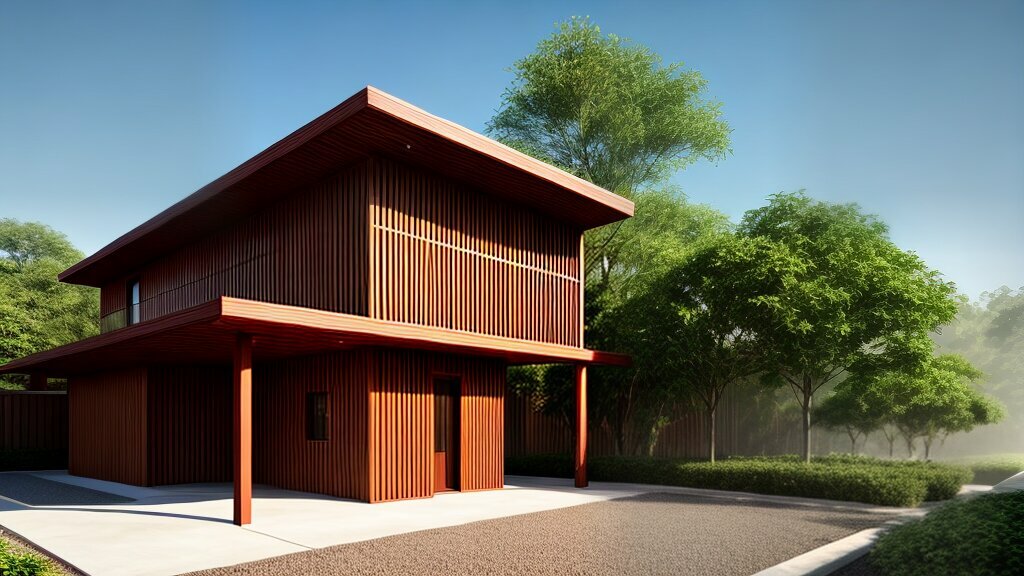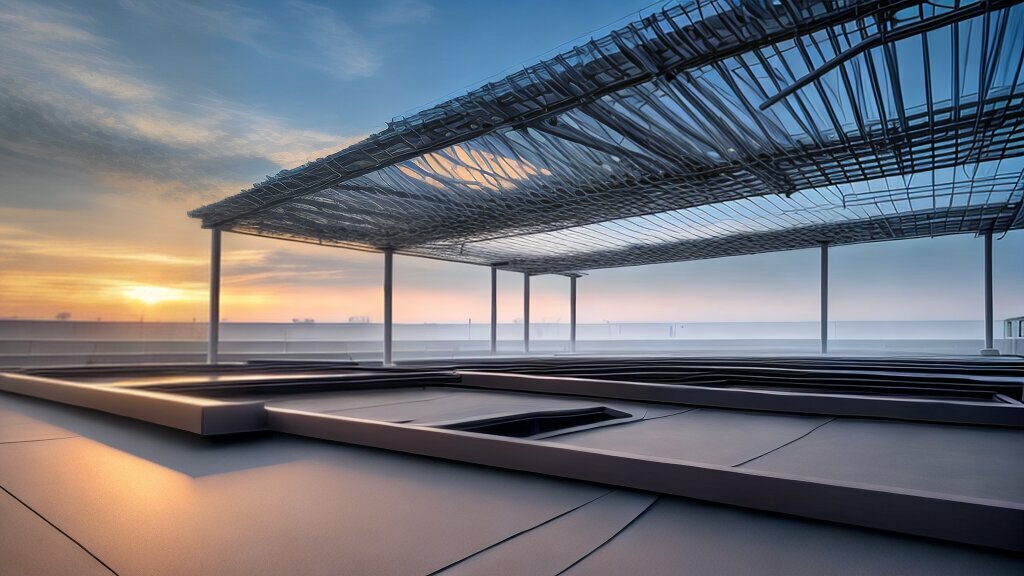Welcome to our article on the importance of biodegradable and recyclable building components in the construction industry. With sustainability becoming an increasingly pressing issue, it is crucial for us to explore eco-friendly construction materials that have minimal environmental impact. Today, we will delve into the world of sustainable building solutions and highlight the benefits of implementing biodegradable and recyclable components in construction projects.
Key Takeaways
- The construction industry needs to adopt sustainable building practices to minimise environmental impact
- Biodegradable and recyclable building components can help achieve this goal
- Using these eco-friendly materials reduces waste, conserves resources and promotes a circular economy
The Need for Eco-Friendly Construction Materials
The construction industry has long relied on traditional building materials like concrete, brick, and steel. While these materials are durable and strong, they have a significant environmental impact. The extraction, production, and transportation of these materials result in high levels of carbon emissions, making the industry one of the largest contributors to climate change.
Therefore, there is a growing need for eco-friendly construction materials that can offer more sustainable building solutions. These environmentally friendly construction products can reduce the carbon footprint of the construction industry and help promote a more sustainable future.
The Importance of Sustainable Building Components
Eco-conscious building supplies are necessary to address the environmental impact of traditional building materials. Sustainable construction components like biodegradable and recyclable building materials promote environmentally responsible building practices that can help mitigate the impact of the construction industry on climate change.
Furthermore, as consumers become more conscious of environmental issues and seek out more sustainable products, the demand for these green building materials will continue to grow. Adopting sustainable practices in the construction industry is not only beneficial for the planet, it also provides a competitive advantage for construction companies that prioritize sustainability.

“Sustainable construction components like biodegradable and recyclable building materials promote environmentally responsible building practices that can help mitigate the impact of the construction industry on climate change.”
Introduction to Biodegradable Building Components
In response to the growing concern over environmental sustainability, the construction industry has been actively seeking out alternatives to traditional building materials. One such solution is the development of biodegradable building components. These are materials that are designed to decompose and break down into harmless natural elements after their useful life has ended.
Biodegradable construction materials offer many benefits over their conventional counterparts. They are made from natural, renewable sources, and they have a much lower impact on the environment. Additionally, they can be used in a wide variety of applications, from building facades to insulation materials, without sacrificing quality or durability.
One example of a biodegradable building component is bamboo. Bamboo is an incredibly versatile material that can be used for everything from flooring to furniture. It’s also incredibly sustainable, as it grows quickly and does not require the use of pesticides or fertilisers. Another example is straw bales. These are a common material in eco-friendly homes and are an excellent alternative to traditional insulation materials.
| Benefits of Biodegradable Building Components |
Examples of Biodegradable Building Components |
| Reduced waste and landfill usage |
Bamboo |
| Lower carbon footprint |
Straw bales |
| Renewable and sustainable sources |
Cork |
As the demand for sustainable building solutions continues to grow, it’s likely that more and more construction materials will be developed with biodegradability in mind. These materials offer a promising solution to the problem of waste and pollution in the construction industry, and they have the potential to revolutionize the way we build our homes and infrastructure.

Advantages of Biodegradable Building Components
Using biodegradable construction materials brings many advantages to the construction industry. By incorporating these green construction products into buildings, the industry can reduce waste, conserve natural resources, and improve the overall environmental impact of construction activities.
Reduced Waste: Unlike traditional building materials, biodegradable construction components break down naturally over time. This means that they create less waste at the end of their useful life, reducing the burden on landfills and promoting a more sustainable waste management system.
Resource Conservation: Biodegradable building components are often made from renewable resources, such as plant-based materials or recycled waste. This reduces the demand for non-renewable resources and promotes sustainable resource management practices.
Improved Air Quality: Traditional building materials, such as paints and adhesives, can release volatile organic compounds (VOCs) into the air. Biodegradable materials, on the other hand, are often low-emitting or emit no VOCs, contributing to better indoor air quality.
| Advantages of Biodegradable Building Components |
Image |
| Reduced Waste: Biodegradable building components create less waste at the end of their useful life, reducing the burden on landfills and promoting a more sustainable waste management system. |
 |
| Resource Conservation: Biodegradable building components are often made from renewable resources, such as plant-based materials or recycled waste, promoting sustainable resource management practices. |
| Improved Air Quality: Biodegradable materials are often low-emitting or emit no volatile organic compounds (VOCs), contributing to better indoor air quality. |
In summary, biodegradable building components offer many advantages over traditional building materials. These green construction products contribute to waste reduction, promote resource conservation, and improve indoor air quality, making them an ideal solution for sustainable construction.
Exploring Recyclable Building Materials
As the demand for sustainable building solutions continues to grow, recyclable building materials have emerged as a promising alternative to traditional products. These green building materials are designed to be reused or repurposed at the end of their life cycle, rather than being discarded as waste.
Recyclable building materials can include anything from recycled steel and plastics to wood and glass. The goal is to reduce the amount of waste generated during construction and decrease the need for new raw materials.
In fact, according to a report by the National Institute of Standards and Technology, the use of recyclable building materials can result in significant energy savings and reduced carbon emissions. These materials also help to increase resource efficiency and promote a circular economy.

Types of Recyclable Building Materials
Recyclable building materials come in a variety of forms, each with its own unique characteristics and benefits. Some of the most common types of recyclable building materials include:
| Type |
Description |
| Recycled wood |
Wood sourced from demolished buildings or salvaged from other sources |
| Recycled steel |
Steel that has been repurposed from other products or buildings |
| Recycled plastic |
Plastic materials that have been reused or repurposed from various sources |
| Recycled glass |
Glass that has been repurposed from other products or buildings |
These materials can be used in a variety of construction projects, from residential homes to large commercial buildings.
The Advantages of Recyclable Building Materials
Using recyclable building materials can offer a number of advantages over traditional construction products. Some of the main benefits include:
- Reduced waste: By using recyclable materials, less waste is generated during the construction process.
- Less reliance on new raw materials: Recycling materials reduces the need for new resources, which can help to conserve natural resources and reduce the environmental impact of construction.
- Energy savings: As mentioned earlier, using recyclable building materials can result in significant energy savings, which can help to reduce carbon emissions and promote a more sustainable future.
Overall, the use of recyclable building materials is a key component of sustainable construction solutions, and is vital to creating a more environmentally friendly and resource-efficient industry.
Benefits of Recyclable Building Materials
Recyclable building materials offer numerous benefits over traditional building materials. They help to reduce the environmental impact of construction activities and promote a more sustainable future. Here are some of the key benefits of using recyclable building materials:
- Reduced energy consumption: Recyclable building materials require less energy to produce than traditional building materials. This is because they often involve less processing and manufacturing. By using recyclable building materials, we can reduce our energy consumption and lower our carbon footprint.
- Waste reduction: Recyclable building materials can be reused and repurposed, reducing the amount of waste generated during construction activities. This helps to conserve natural resources and decrease the amount of waste sent to landfills.
- Improved indoor air quality: Some recyclable building materials, such as recycled insulation and low-VOC paint, can improve indoor air quality and promote healthier living environments. This is because they often contain fewer harmful chemicals and pollutants than traditional building materials.
- Lower costs: While the initial cost of recyclable building materials may be higher than traditional building materials, they often offer cost savings in the long run. This is because they require less maintenance and last longer than traditional building materials.
- Promotion of circular economy: Recyclable building materials contribute to a circular economy by promoting the reuse and repurposing of materials. This helps to conserve natural resources and reduce waste.

Applications of Biodegradable and Recyclable Building Components
Biodegradable and recyclable building components have a wide range of applications in the construction industry, from residential buildings to commercial projects. These sustainable construction materials can be used in various ways, offering eco-conscious building supplies that are durable, reliable and cost-effective.
One example of biodegradable building components is cellulose insulation, which is made from recycled newspaper and can be used for insulation in walls, floors and ceilings. It is also an excellent sound insulator, providing an extra layer of noise reduction in buildings.
| Biodegradable Building Components |
Applications |
| Bamboo |
Flooring, roofing, walls |
| Cork |
Flooring, insulator, roofing |
| Hempcrete |
Insulation, walls |
Recyclable building materials such as steel and glass can also be used in construction projects. Steel is an excellent choice for building frames and supports, while glass can be used for windows and skylights.

Another example of recyclable building materials is recycled plastic lumber, which can be used for outdoor construction projects such as decking and fences. This material is highly durable and can withstand harsh weather conditions.
The applications of biodegradable and recyclable building components are not limited to new construction projects. These materials can also be used in retrofitting existing buildings, providing a sustainable solution for improving the energy efficiency of older buildings.
Challenges and Considerations
While the benefits of using biodegradable and recyclable building components in construction are numerous, there are also some challenges and considerations to keep in mind.
Cost: One of the main challenges associated with eco-conscious building supplies is their cost. Biodegradable and recyclable materials can be more expensive than traditional options due to their production processes and limited availability. However, as demand increases and production costs decrease, the prices may become more competitive.
Availability: Another consideration is the availability of green building materials. Local availability and access to eco-friendly products can vary widely depending on location. This can make it challenging for builders to source sustainable materials for their projects.
Performance: There can also be concerns about the performance of biodegradable and recyclable building components. While these materials are designed to be durable and long-lasting, they may not always perform as well as traditional materials in certain conditions. Builders need to carefully assess the suitability of these materials for their specific projects.
Education: Finally, there is a need for education and training when it comes to using and implementing sustainable building solutions. Many builders and architects may not have experience working with these materials and may require additional training to ensure proper installation and maintenance.
Despite these challenges, the benefits of using biodegradable and recyclable building components in construction far outweigh the drawbacks. By carefully considering the challenges and taking steps to overcome them, builders can help create a more sustainable future for the construction industry.

Future Outlook for Sustainable Construction
The demand for eco-conscious building supplies has been on the rise, and with the push towards sustainable development, it is likely that the use of biodegradable and recyclable building components will continue to grow in popularity. As governments and businesses increasingly prioritize environmental sustainability, the construction industry will have to adapt to meet these demands.
Fortunately, research is constantly being done to develop new and innovative eco-friendly building materials. For instance, scientists are currently working on creating bioplastics from renewable materials like corn starch and cellulose that can be used as a biodegradable alternative to traditional plastics. Similarly, advancements in technology are paving the way for more efficient and cost-effective recycling processes, making it easier to reuse materials in construction.
Furthermore, with more and more consumers becoming environmentally conscious, it is likely that demand for green building materials will continue to increase. As a result, construction companies that adopt sustainable building solutions are likely to see increased business opportunities and growth.

Overall, the future outlook for sustainable construction is promising, with the construction industry increasingly recognizing the importance of reducing its environmental impact. Through the adoption of biodegradable and recyclable building components, as well as continued research and innovation, the industry can make significant strides towards a more sustainable future.
Case Studies: Successful Implementation of Sustainable Building Components
In recent years, the construction industry has seen the successful implementation of biodegradable and recyclable building components in various projects across the globe. Let’s take a look at some of these projects and how they have utilized sustainable building solutions to reduce their environmental impact.
Akron Children’s Hospital, Ohio
Akron Children’s Hospital in Ohio recently implemented a biodegradable roofing system made from cornstarch. This innovative system not only reduces waste in landfills but also improves energy efficiency by keeping the building cool during hot summer months. The biodegradable material also eliminates the need for future replacement, thus reducing maintenance costs in the long run.

The Edge, Amsterdam
The Edge is a sustainable office building in Amsterdam that has been certified as the most sustainable office in the world. The building features a wide range of eco-conscious building supplies, including a rooftop solar array, energy-efficient lighting and heating, and a smart building management system that allows employees to adjust lighting and temperature settings with a smartphone app. Additionally, the building’s construction materials, such as the steel and aluminium used in the building’s frame, are made from recycled materials.
One Angel Square, Manchester
One Angel Square in Manchester is a sustainable office building that has been awarded the highest BREEAM rating for environmental performance. The building’s construction includes a range of sustainable materials, including the use of recycled concrete in the building’s structure, and the use of timber from sustainable sources. The building also features a rainwater harvesting system, which allows rainwater to be collected and used for irrigation and flushing toilets.
“Sustainable building components are not only good for the environment, but they also offer long-term benefits by reducing maintenance costs and improving energy efficiency. As these case studies show, the implementation of biodegradable and recyclable building components is a viable solution for creating a more sustainable future in the construction industry.”
Conclusion
In conclusion, it is clear that the use of biodegradable and recyclable building components is a significant step forward for sustainable construction. The need for eco-friendly materials in the industry is pressing, as the environmental impact of traditional building materials continues to be a growing concern.
Biodegradable building components offer a practical solution to reducing waste and conserving resources, while recyclable building materials promote a circular economy and can significantly reduce energy consumption. It is important to note that challenges and considerations exist when it comes to using these materials, such as cost and availability, but the potential for growth and impact in the future of sustainable construction is optimistic.
Looking Ahead
As construction companies and architects continue to prioritize eco-conscious building supplies, the use of biodegradable and recyclable building components will undoubtedly become more widespread. In fact, there are already successful case studies showcasing the benefits of these sustainable building products.
It is essential that we work towards a more sustainable future in the construction industry, and adopting biodegradable and recyclable building components is a crucial step in the right direction. By reducing waste, conserving resources, and promoting circular economy, these materials offer a practical and environmentally friendly solution to traditional building methods.
FAQ
Q: What are biodegradable building components?
A: Biodegradable building components are construction materials that have the ability to break down and decompose naturally over time. They are designed to minimize the environmental impact associated with traditional building materials.
Q: How do biodegradable building components contribute to sustainability in construction?
A: Biodegradable building components contribute to sustainability in construction by reducing waste and resource consumption. They help minimize the carbon footprint of building projects and promote a more environmentally friendly approach to construction.
Q: What are the advantages of using biodegradable building components?
A: Using biodegradable building components offers several advantages, including reduced waste generation, conservation of resources, and a lower environmental impact. They also contribute to improved indoor air quality and can be used to create healthier living environments.
Q: What are recyclable building materials?
A: Recyclable building materials are construction products that can be processed and reused at the end of their life cycle. They are designed to promote a circular economy by reducing waste and conserving valuable resources.
Q: What are the benefits of using recyclable building materials?
A: The use of recyclable building materials provides several benefits, including reduced energy consumption, waste reduction, and a more sustainable approach to construction. They also contribute to the preservation of natural resources and help minimize the environmental impact of construction projects.
Q: In what applications can biodegradable and recyclable building components be used?
A: Biodegradable and recyclable building components have a wide range of applications in various construction projects. They can be used for structural elements, insulation, flooring, and even decorative purposes. Their versatility makes them suitable for both residential and commercial buildings.
Q: What challenges or considerations should be taken into account when using biodegradable and recyclable building components?
A: Some challenges associated with the use of biodegradable and recyclable building components include cost and availability. These sustainable materials may be more expensive and less widely available compared to traditional alternatives. It is important to carefully assess the feasibility and long-term benefits before implementing them in a construction project.
Q: What is the future outlook for sustainable construction with biodegradable and recyclable building components?
A: The future of sustainable construction is promising with the growing adoption of biodegradable and recyclable building components. These materials are expected to play a significant role in reducing the environmental impact of the construction industry and promoting a more sustainable approach to building.
Q: Can you provide examples of successful implementation of biodegradable and recyclable building components?
A: There are numerous real-life examples of construction projects that have successfully utilized biodegradable and recyclable building components. From eco-friendly residential buildings to large-scale commercial developments, these projects demonstrate the viability and benefits of sustainable construction.



























Post comments (0)